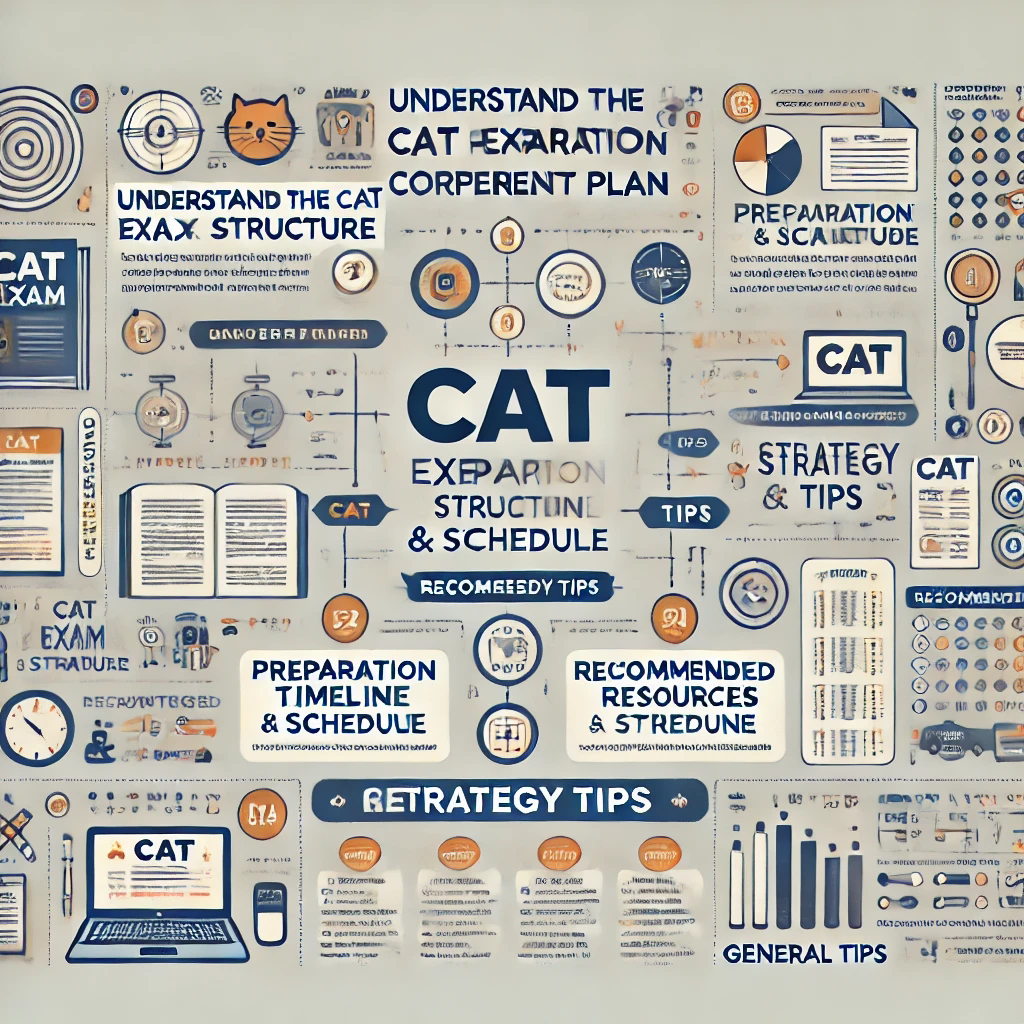CAT Exam Preparation Coherent Plan
1. Understand the CAT Exam Structure
- Sections: CAT has three sections:
1. Verbal Ability & Reading Comprehension (VARC)
2. Data Interpretation & Logical Reasoning (DILR)
3. Quantitative Aptitude (QA)
- Duration: 2 hours (40 minutes per section)
- Marking: +3 for correct answers, -1 for incorrect answers (MCQs only), no negative marking for non-MCQs.
2. Preparation Timeline & Schedule
Phase 1: Build Foundations (Months 1-2)
- Focus on strengthening the basics in each section.
- Quantitative Aptitude: Cover topics like arithmetic, algebra, geometry, and number systems.
- Data Interpretation & Logical Reasoning: Practice different types of puzzles, data sets, and logical reasoning exercises.
- Verbal Ability & Reading Comprehension: Start reading newspapers, editorials, and novels to improve reading speed and comprehension.
Daily Plan:
- 2 hours of QA: Topic-wise conceptual clarity.
- 1 hour of DILR: Solve different types of sets.
- 1 hour of VARC: Read articles and solve comprehension passages.
Phase 2: Practice and Enhance (Months 3-4)
- Start taking sectional tests to develop familiarity with each section's structure and time constraints.
- Focus on topics that are causing difficulties and improve on weak areas.
- Quantitative Aptitude: Increase speed by practicing a mix of easy and moderate-level questions.
- DILR: Solve diverse sets, focusing on accuracy and logical deduction.
- VARC: Engage in reading comprehensions, para jumbles, and vocabulary exercises.
Weekly Plan:
- 4-5 full-length sectional tests: Evaluate strengths and weaknesses.
- Daily reading: Editorials from newspapers like The Hindu or The Indian Express.
Phase 3: Mock Tests & Analysis (Months 5-6)
- Take full-length mock tests (2-3 per week).
- Analyze each test thoroughly to understand errors and improve strategies.
- Work on time management and adapt to the exam's pressure.
- Focus on accuracy over speed to maximize the score.
Mock Test Routine:
- Day 1: Take the mock test.
- Day 2: Analyze results in detail—identify incorrect answers, skipped questions, and weak areas.
- Days 3-5: Revise and improve based on the analysis.
- Day 6: Solve past CAT papers (last 5 years).
Phase 4: Revision & Final Push (Last Month)
- Revise all important concepts and formulae.
- Focus more on strong areas and maximize scoring potential.
- Take daily mock tests, but keep time for relaxation to avoid burnout.
- Practice mental math for QA and review shortcut techniques.
Daily Routine:
- 1-2 mock tests in exam-like conditions.
- 2-3 hours of revision: Focus on formulas, concepts, and test strategies.
- Reading: Continue reading to maintain reading speed and comprehension.
3. Strategy Tips
- VARC: Focus on reading speed and comprehension accuracy; attempt para jumbles with elimination techniques.
- DILR: Start with easier sets to secure marks, then attempt complex sets; keep calm while solving puzzles.
- QA: Practice mental calculations and shortcut techniques; prioritize easy questions first to secure marks.
4. Recommended Resources
- Books:
- QA: Quantitative Aptitude for CAT by Arun Sharma.
- DILR: How to Prepare for Data Interpretation for CAT by Arun Sharma.
- VARC: Word Power Made Easy by Norman Lewis; read daily newspapers and magazines.
- Online Resources: BYJU’s, Unacademy, TIME, IMS.
- Mock Tests: TIME, IMS, Career Launcher, and official IIM CAT mock tests.
5. General Tips
- Stay Consistent: Daily practice and regular tests are key.
- Healthy Routine: Proper sleep, nutrition, and exercise to maintain mental stamina.
- Stay Updated: Read newspapers daily for general awareness and reading comprehension improvement.
- Adapt and Improve: Regularly adjust strategies based on mock test performance.
This structured plan can be adjusted to fit personal preferences, strengths, and available time for preparation. Focus on consistent effort, disciplined practice, and a positive mindset throughout the journey.

Comments
Post a Comment
Share this to your friends